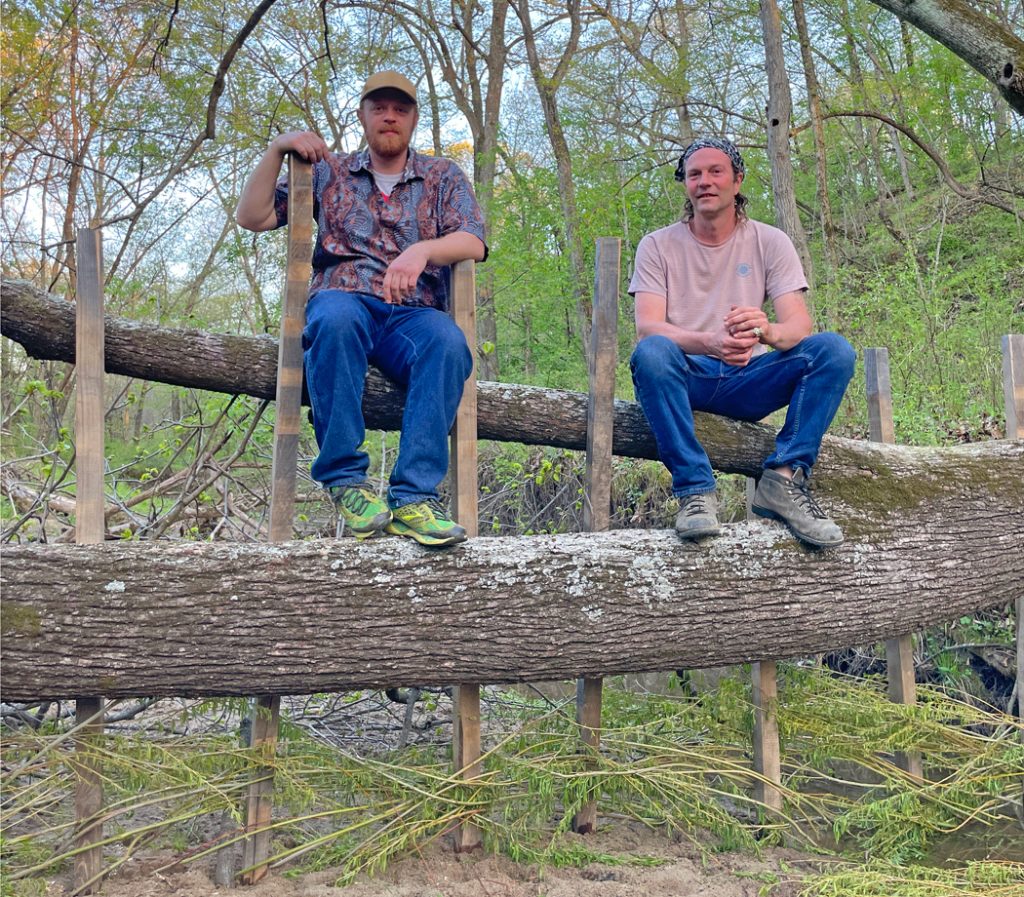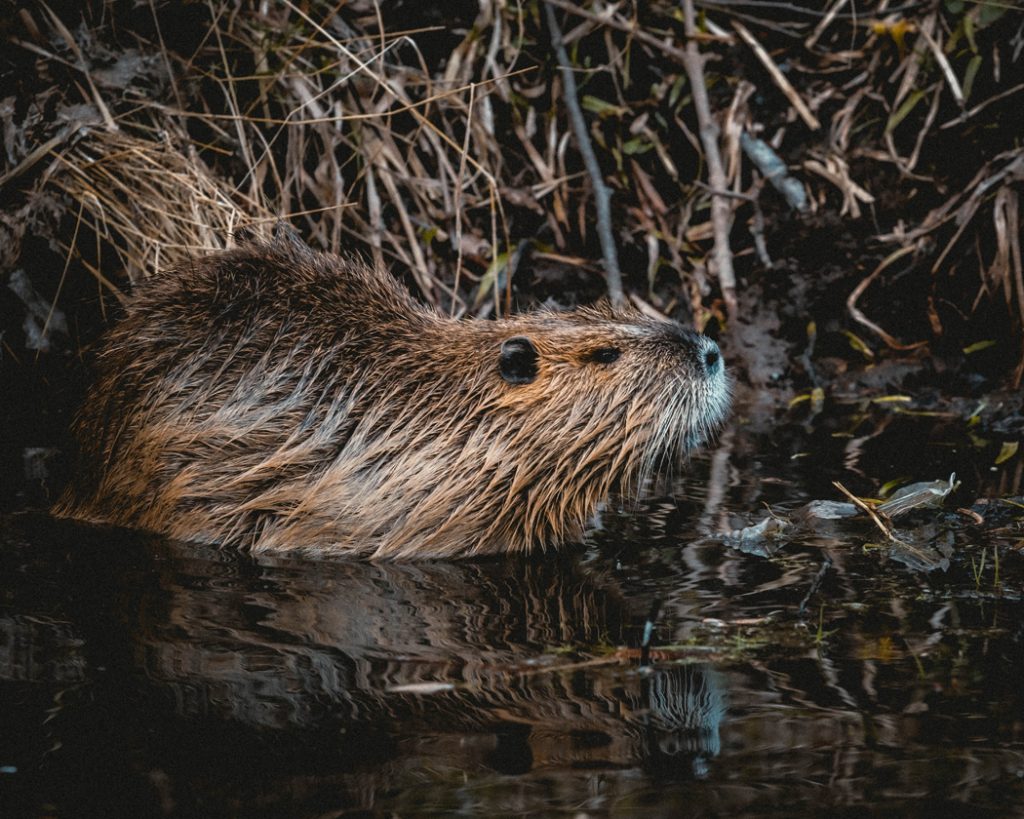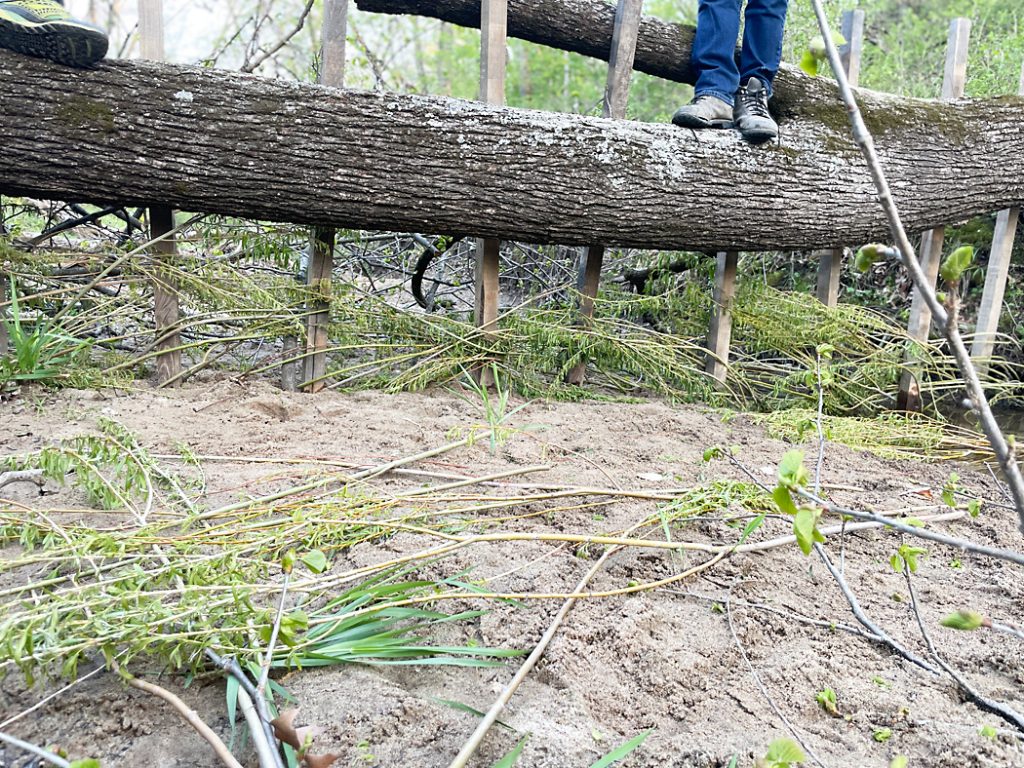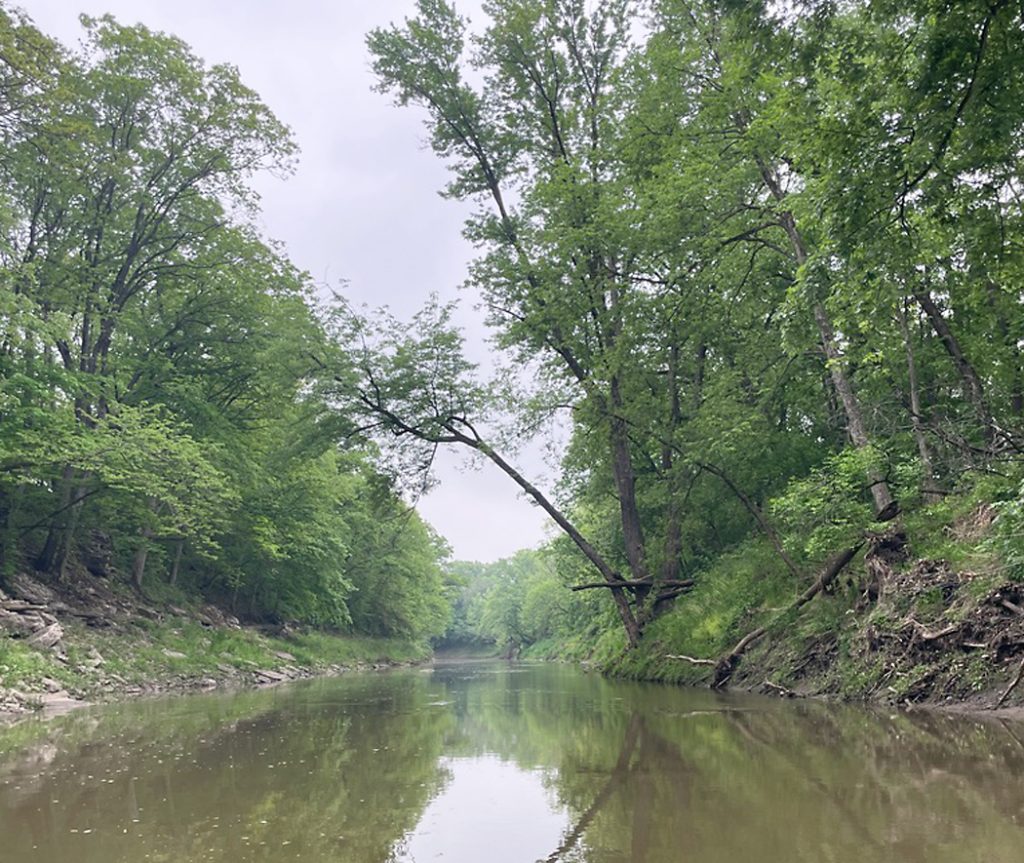
Are beavers more important than humans?” Chris Sorflaten asks. We’re floating down Cedar Creek in Jefferson County, where he often encounters the inquisitive aquatic rodents. “Usually the first time of the year, they’re real skittish, and they’ll do a tail slap,” Sorflaten says. “But the next few times they like to come and play with the paddles and swim under the bow. They’re super friendly and playful.”
It’s an overcast day, and the green reflections of maple, birch, cottonwood, horsetail grass, and cordgrass are mirrored in a double corridor of green. There’s no algae today, but the water is translucent amber with fine clay. Families of Canada geese swim along the bank. More than once, a deer bounds through the shallow water. We even see a turkey flying low from bank to bank.
But what interests Sorflaten most is the shifting topography of the creek and its tributaries. He’s been visiting for 18 years, watching the slick barren clay grow green with the return of native grasses and wildflowers, seeing broad sandbars appear and disappear, and keeping his eye on the shape of the tributaries joining the stream. His imagination keeps returning to what it would look like if there were more beavers.

“North America might better be termed Beaverland,” writes Ben Goldfarb, author of Eager. Beavers are wetland architects, directing water to flood plains and slowing its course. This flooding allows water to infiltrate into the soil and even underground, replenishing aquifers. Rich sediment deposits also collect in the flood zones, instead of being whisked off to the Mississippi and ultimately Louisiana’s gulf. If a frog or a fish were to answer Sorflaten’s question, odds are they would say beavers are more important than humans. Beavers are a keystone species that literally build habitat for amphibians, waterfowl, and fish.
But most landowners still consider them pests. Their wetland wizardry is most appreciated by ranchers in arid states who see the benefit of slowing down water. Many farmers fear losing cropland to historic floodplains, even in drought-plagued California.
Sorflaten is frustrated by the steep and narrow tributaries—practically trenches— that feed into Cedar Creek. “It just rained and they’re already dry,” he notes. Major creeks like Cedar Creek are highways for beavers and other wildlife to move throughout the state, and their tributaries act as local roads. When tributaries run dry or have steep banks, it makes access difficult. Winding streams with gently sloped banks and shallow pools are not only more accessible but offer a full suite of micro ecosystems and nursery habitat.
There’s a stark contrast between the beaver-managed wetland Sorflaten believes is possible and the current reality. This stretch of Cedar Creek runs through heavily tilled farmland without cover crops, susceptible to erosion from snowmelt and spring rains. The USDA considers up to 5 tons of soil loss per acre per year sustainable. According to a 2007 ISU study, the farmland around Cedar Creek loses 5–20 tons per acre each year.
Beaver Dam Analogs
Chris Busch and Chris Sorflaten aren’t waiting for beavers to solve the problem. The two friends independently got involved in wetland restoration and beaver dam analogs (BDAs) and decided to team up. Beaver dam analogs are a popular conservation tool throughout the U.S. They’re structures in streams made of untreated wood designed to trap debris and accumulate enough sticks and twigs over time to form imitation beaver dams, slowing the current and creating wetland habitat. They also attract beavers.
Conservation scientists see BDAs as a highly cost-effective approach. “Relying on the labor of a rodent helps a ton,” quips Utah State University geomorphologist Joe Wheaton. In many cases, when conservationists build BDAs, beavers will come and take charge of wetland restoration from there. In the meantime, the BDA serves to slow water, trap sediment, and create habitat for native fish, fowl, and frogs.
Busch and Sorflaten invite me to see a new BDA they installed for a client who wants to entice beavers to relocate from a pond to a creek. It’s a sunny evening, and I follow one gravel road to another to a hidden driveway. Chickens mill about, and two sheep bleat incessantly like a horror film soundtrack. I make my way down-slope toward the creek past ruffly river birches and white pine. The creek is low and clear, surrounded by timber, and sandier than most in the area. Eventually, I hear Busch’s voice beyond an old barn.

This BDA consists of a newly felled tree straddling the creek, held in place by vertical posts with slender green willow branches woven through the bottom. Busch explains the importance of the gentle U of the tree to widen the stream and create shallows near the bank while channeling water through the middle. The two men mill the posts themselves from local rot-resistant wood. Willow, like birch and cottonwood, is among the beavers’ favorite foods. Willow is uniquely well-suited to rooting in water, and they’ve put in extra along the bank. They hope the beavers will be enticed by their favorite snack. But even a beaverless BDA will be beneficial for water management and other wildlife. It’s a way humans can work with beavers to stymie erosion and the growing dead zone in the gulf of Mexico.
Shaped by Beavers
Sorflaten completed the Beaver Institute’s BeaverCorp program after learning about its founder in Eager by Ben Goldfarb. “I was sold,” he told me. “A career path opened up.” Eager is an utterly delightful and witty read that explores how North America’s landscape was shaped by beavers, the impact of their relative absence, and how our two species might coexist. The fate of numerous wetland species, including insects that serve as the vital base of the food chain, depends on our ability to negotiate with beavers. Killing beavers proves ineffective; it’s only a matter of time before another beaver family recognizes the perfection of the same dam site. Beaver believers across the country, Busch and Sorflaten included, serve as interspecies mediators.
Busch is well aware of the potential conflicts. “People who have prized trees can think of beavers as a nuisance,” he explains. “But there are pretty easy tree protection measures—we can either educate people or do it for them. And then flooding is the other one.”
Part of beavers’ bad reputation comes from clogging culverts and flooding roads. “It’s usually not an issue with ponds,” Busch notes, “because they’re not damming the pond there, they just build their lodge in the pond. But we do have to watch out for where we attract beavers along creeks. Like, for example, this site, we had to go pretty far downstream, so as not to affect the road or any of the culverts. That’s a common issue: beavers adopt a site and create a big pool of water. You don’t want to affect human settlements with it.”
In Iowa, that’s easy enough; Fairfield’s beavers have taken up residence in the Neff Wetlands. Sorflaten has monitored them for five years, and notes there are currently five dams. He was recently saddened to find a dead beaver he believes was poached. Throughout our agrarian countryside with its pockets of CRP and hunting land, the majority of our waterways are bordered by untillable land: steep stream buffers edged by trees and wild grasses or low-lying woodland. It’s still possible to find unpeopled places where there are no land-use conflicts. Beavers may be a boon for fishing and hunting: research suggests they increase native fish populations and attract waterfowl.
In more densely populated and forested states such as Massachusetts or New Hampshire, human and beaver relations have been more strained. Fortunately, a variety of simple and cost-effective solutions are possible, mostly involving aquatic fences and hidden drain pipes that are inaccessible to the determined builders. Wildlife scientist turned inventor Skip Lisle is the nation’s expert in nonlethal beaver management. His company Beaver Deceivers LLC works with northeastern municipalities and landowners to craft custom devices. Vermont’s Department of Fish and Wildlife uses Lisle’s flow devices to manage flooding. They’re essentially beaver-proof pipes that drain dams when they reach their maximum. The state has a 90 percent success rate with the 240 flow devices.
Lisle’s determination to outsmart his plush furry friends is driven by his desire to see them flourish. “Most people don’t care about beavers being on the landscape as long as roads aren’t being flooded,” he tells Goldfarb in Eager. “Once you protect the culverts, the cultural carrying capacity becomes basically whatever the landscape will allow.” In other words, the watery civilizations of beavers can coexist with well-drained human civilizations. It only takes some simple technology.
A Fleeting Look
Cedar Creek is slower than anticipated with the recent rain, and as much as I savor the tranquility of drifting lazily downstream and am amused by the distant airy, throaty screeching of what Sorflaten believes are wild turkeys, I’m tempted to get out before the “rapids.” My dogs are scared of the dark and I want to get home along the maze of gravel roads before nightfall. That’s when we see the first shape swimming along a submerged log. Is it a muskrat? A juvenile beaver? We paddle as quietly as we can, but it vanishes between a log and the bank before we can know for sure. Now I want to keep going.

Beavers are highly social, and live in extended family groups if they have a chance to establish themselves for several generations. Nuclear beaver families typically consist of the parents, one-year-old kits, and their new siblings. Where there’s one beaver, there’s likely to be more.
We round a sandy bend and there’s a slap, a splash straight in front of the canoe, and then still water. A beaver. “That was a friendly slap,” Sorflaten says. “He didn’t hide, he looked right at us.” Nonetheless, the beaver doesn’t reemerge for a photo op. The “rapids” are just a shallow rocky patch today, and we scoot our way through easily enough. A cheap price to glimpse the species that shaped our continent and much of our geopolitical history.
Reach Chris Sorflaten by phone at 1 (641) 455-7653 or email csorflaten@gmail.com and Chris Busch by email chris@iowawaterproject.org.
Learn more about at:
